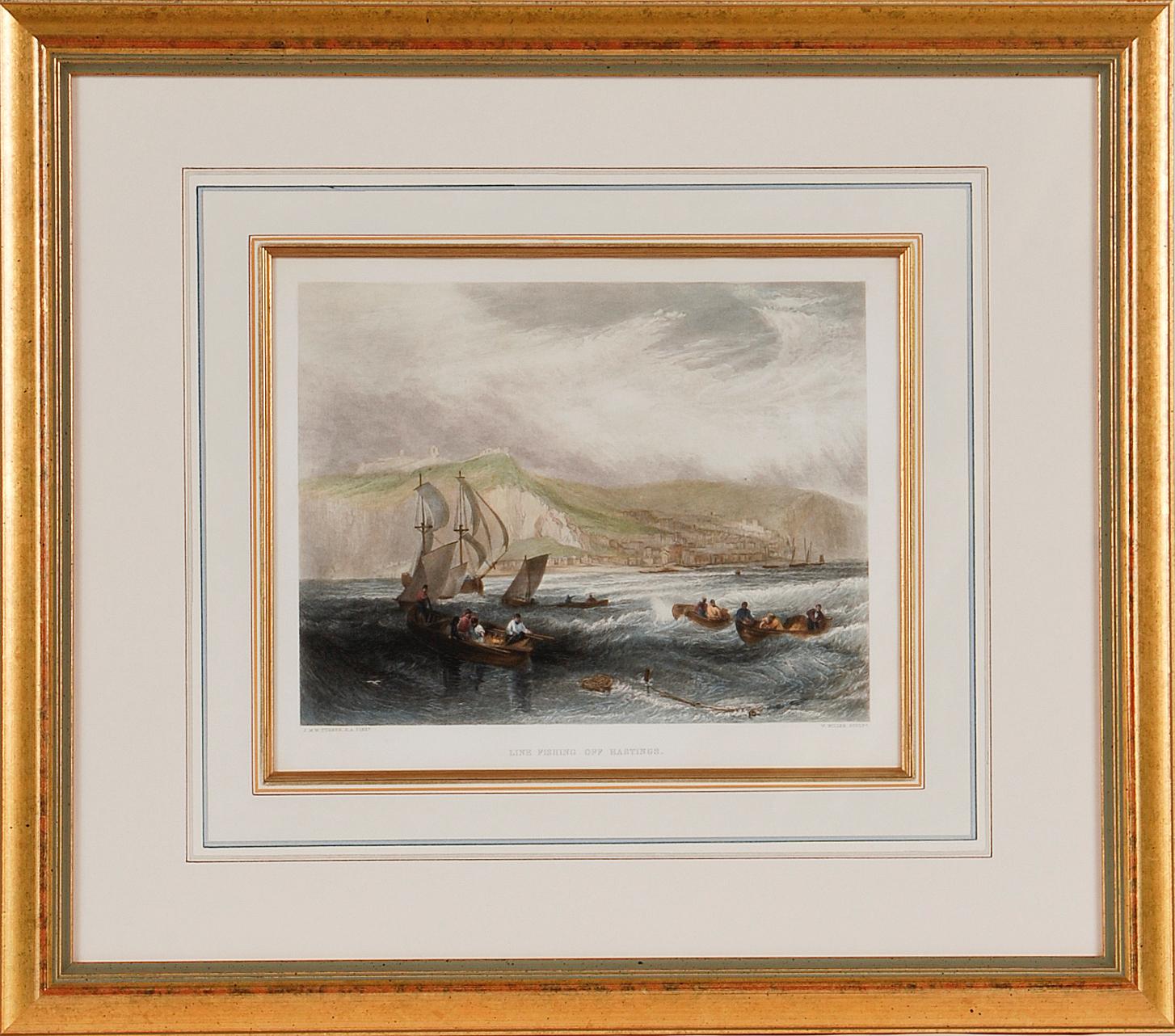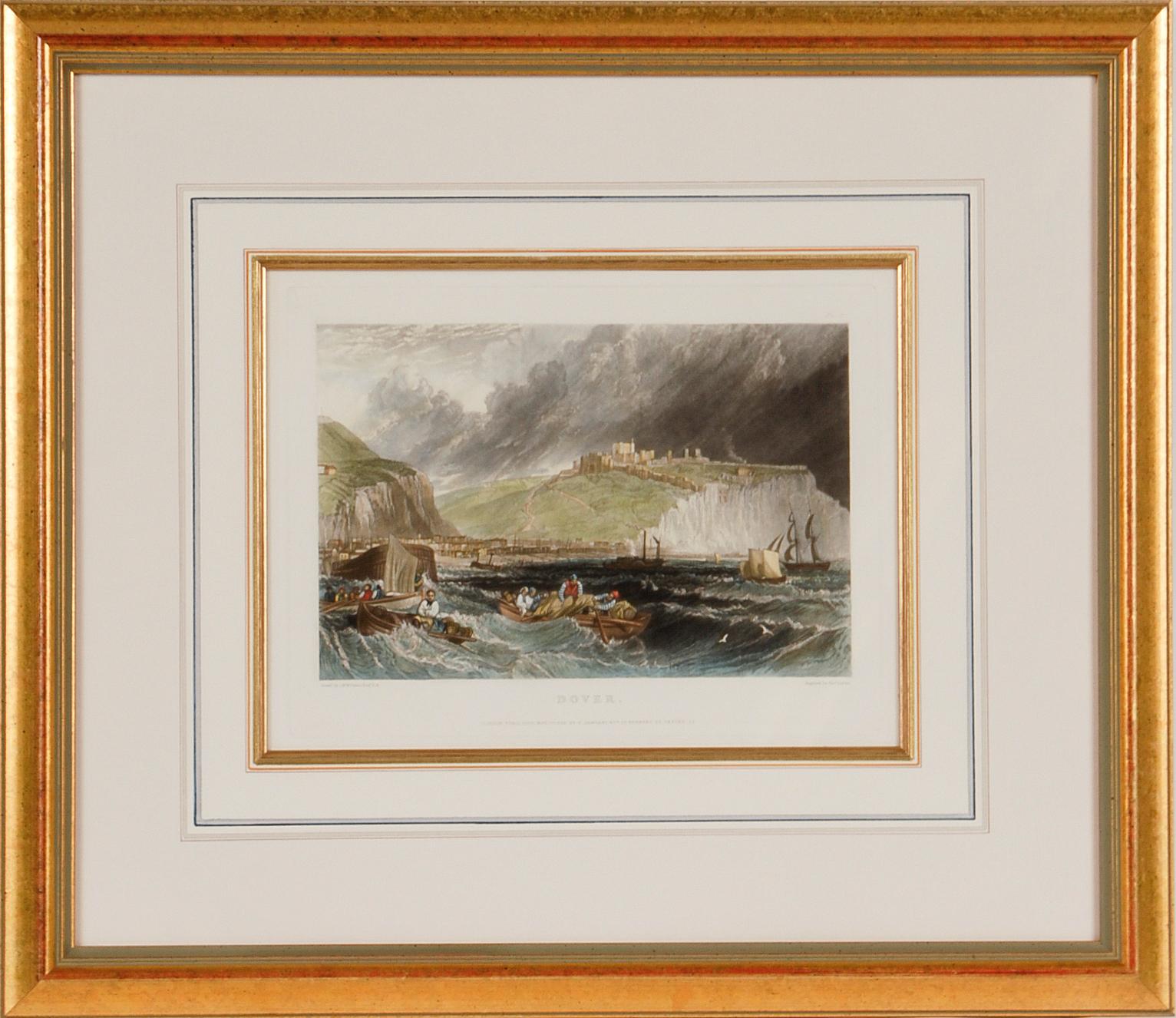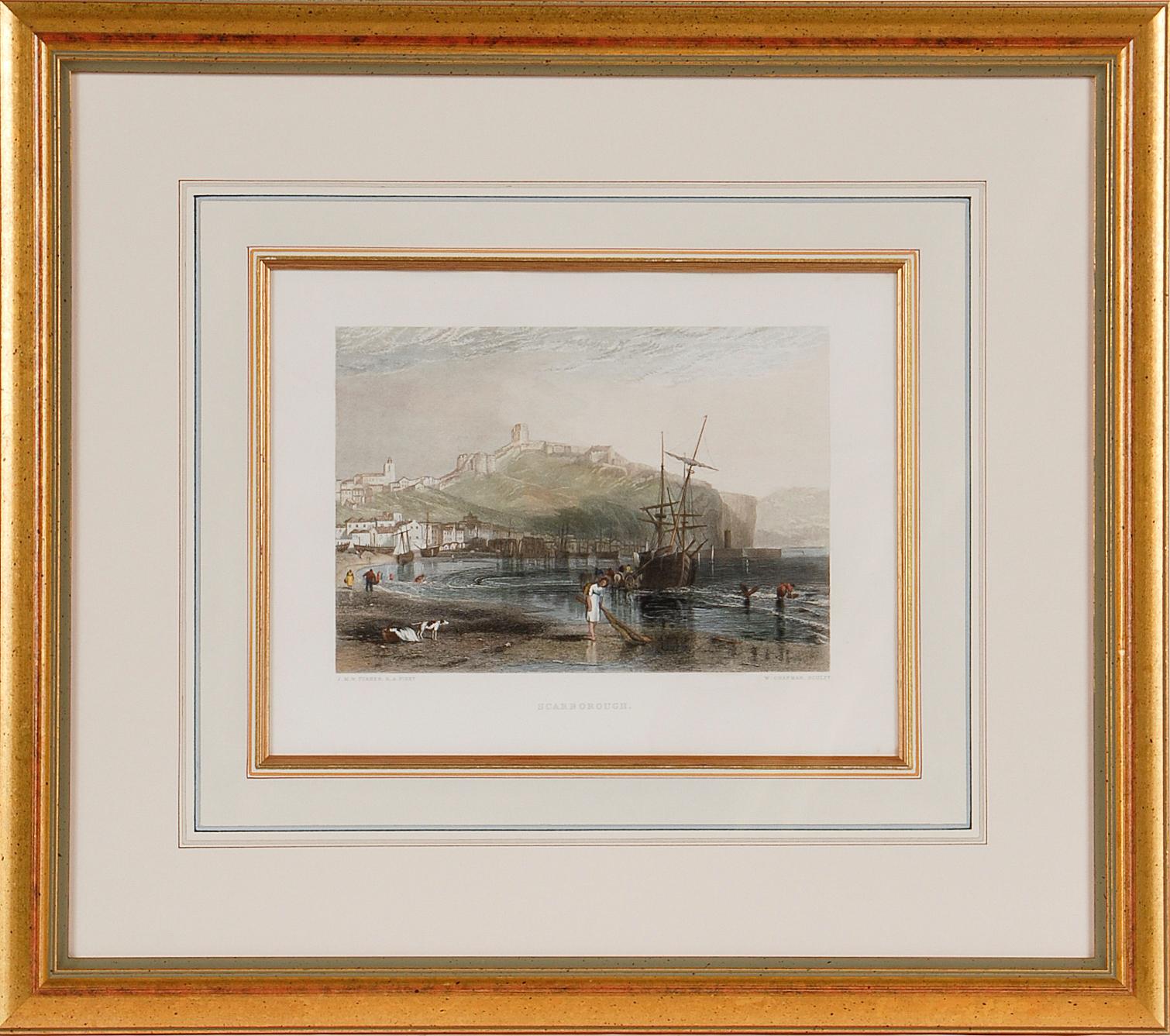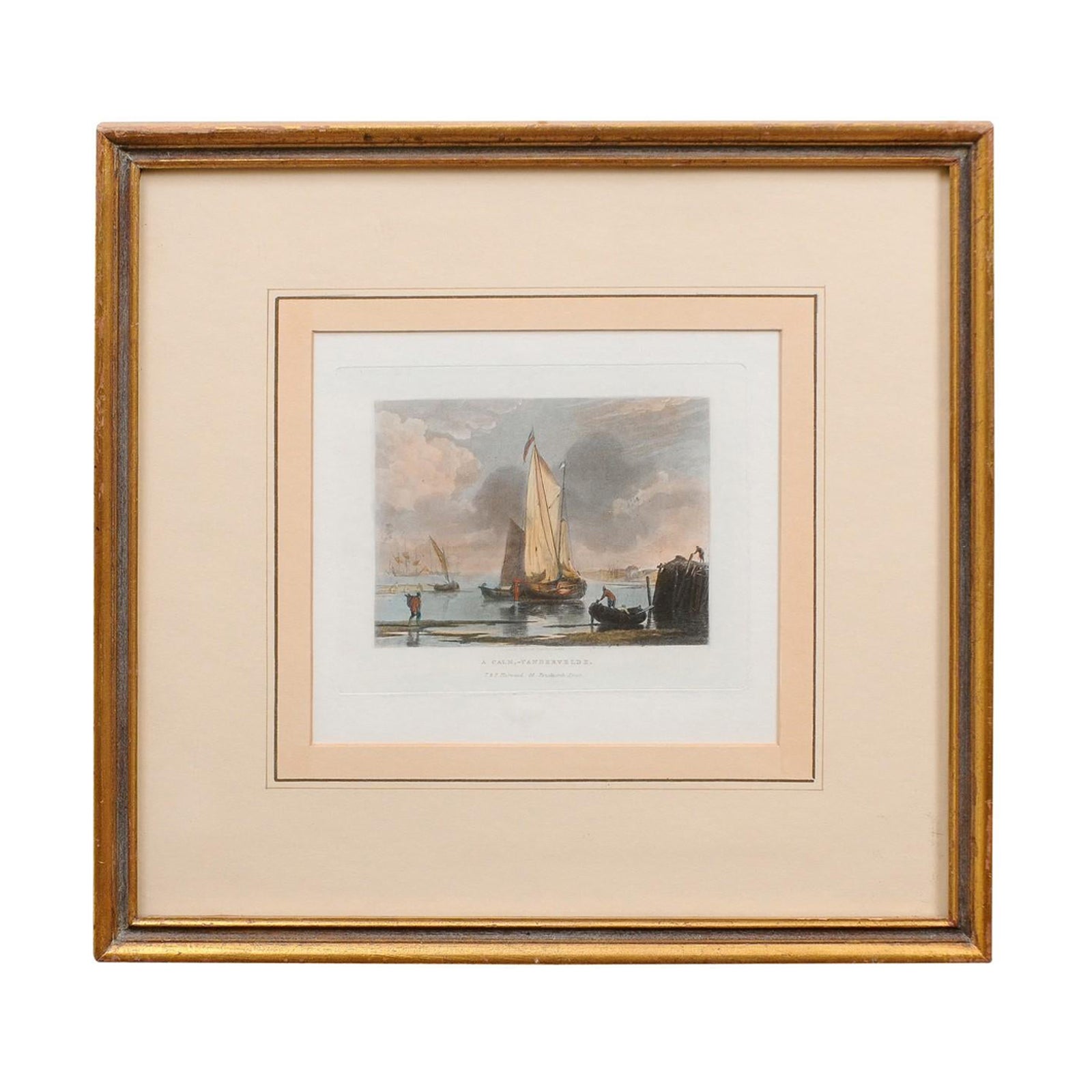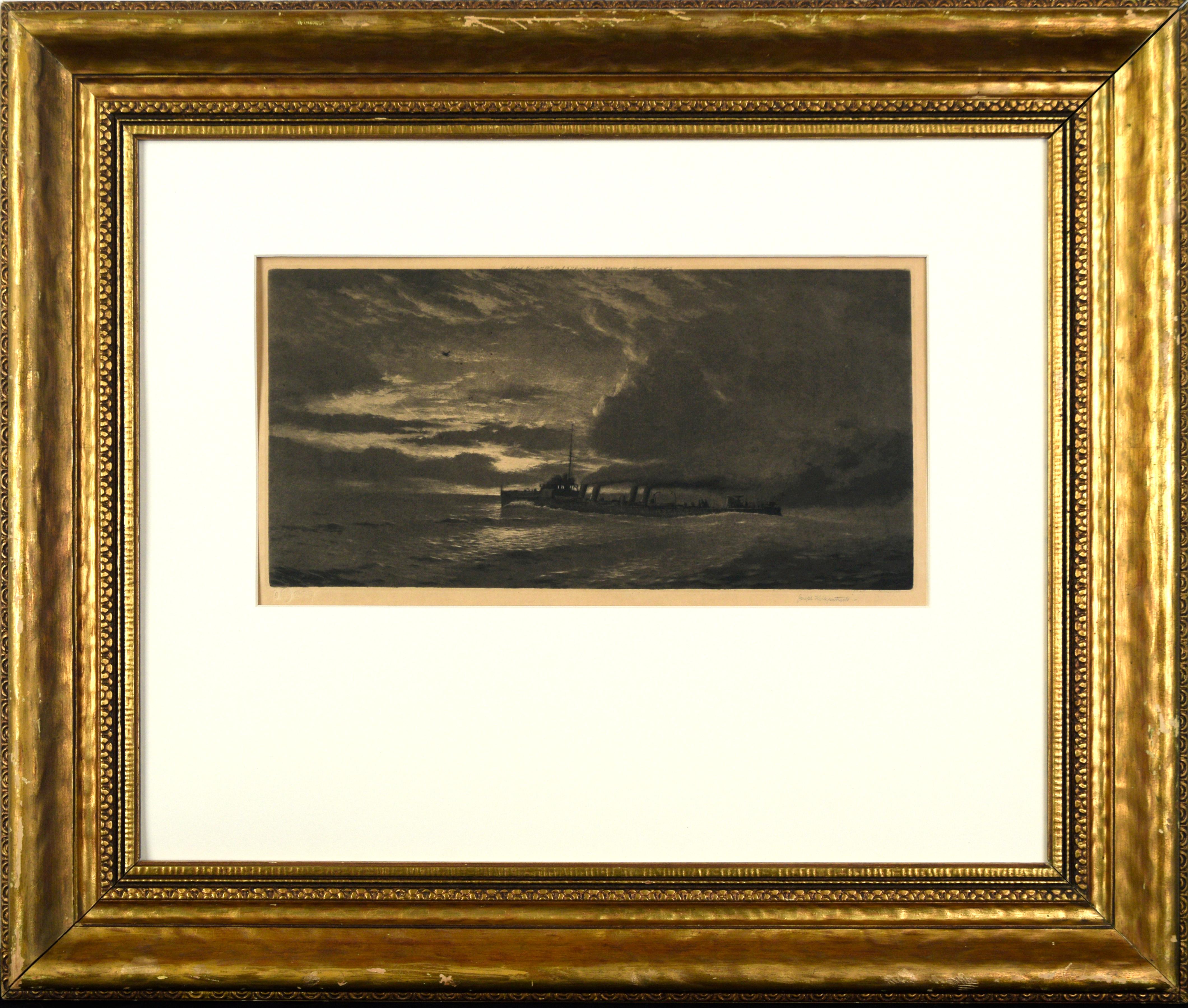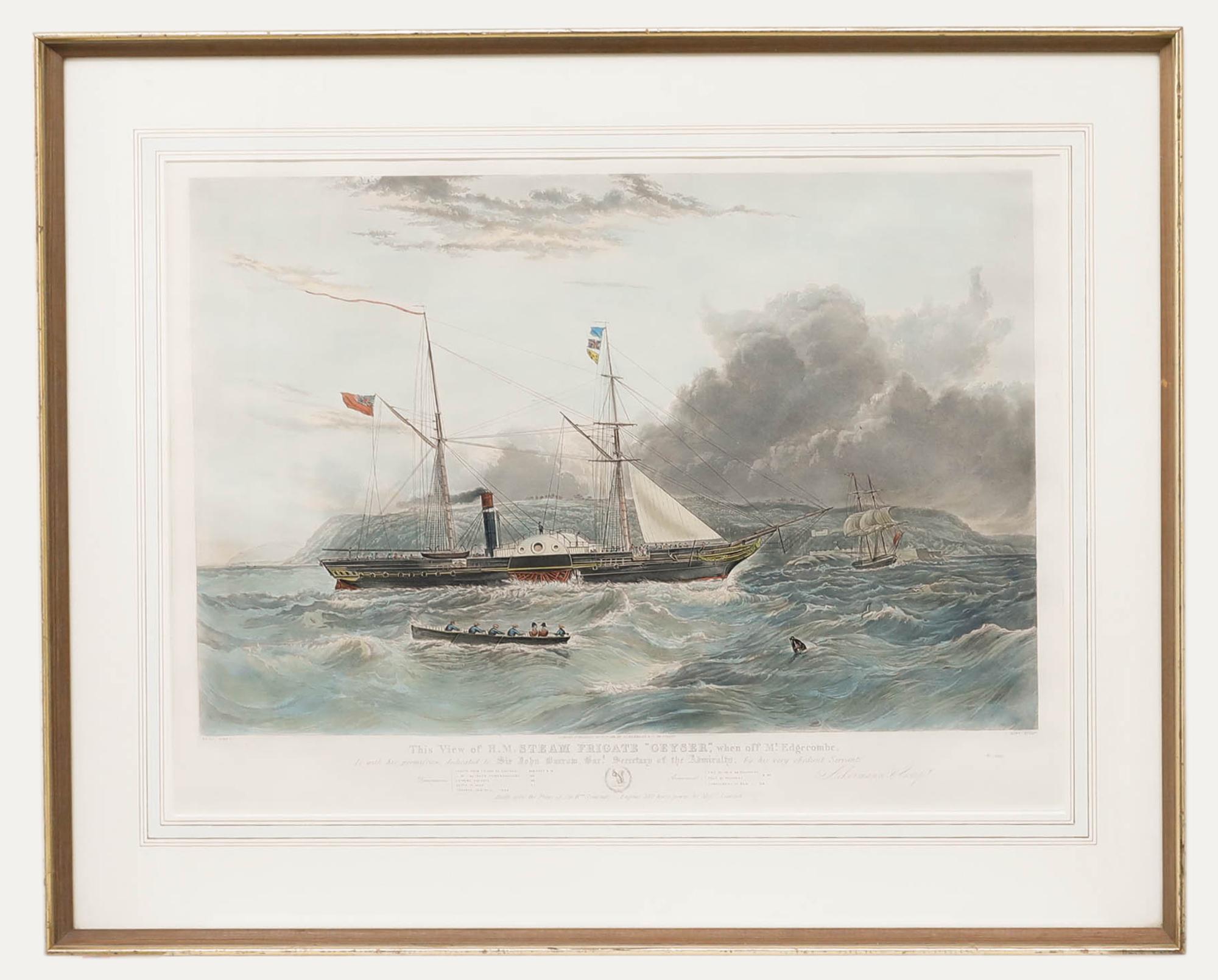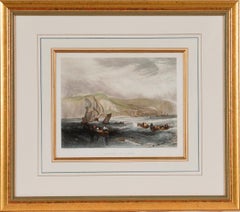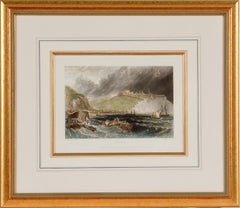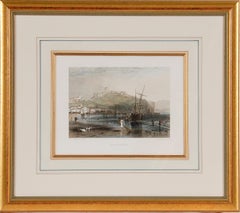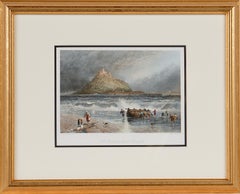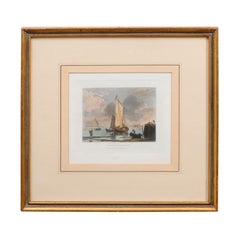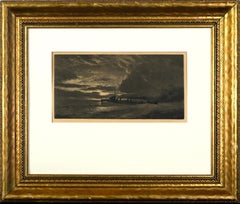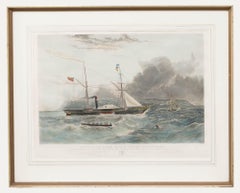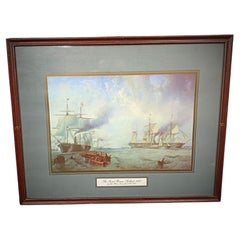Items Similar to The Fighting Temeraire: A Framed 19th C. Engraving After J. M. W. Turner
Want more images or videos?
Request additional images or videos from the seller
1 of 10
The Fighting Temeraire: A Framed 19th C. Engraving After J. M. W. Turner1859
1859
$675
£514.87
€587.57
CA$949.23
A$1,041.80
CHF 547.48
MX$12,397.20
NOK 6,998.43
SEK 6,395.18
DKK 4,389.70
About the Item
This beautiful 19th century framed engraving "The Fighting Temeraire" by James Tibbetts Willmore is based on an original painting by the renowned British artist J.M.W. Turner. It was published by James S. Virtue & Co. in London between 1859-1875. It depicts the once mighty British warship the HMS Temeraire being towed away down the river Thames by a much smaller steamboat to a ship-breaking yard to be broken up for scrap. The Temeraire was first launched in 1798 and represented the pinnacle of British ship-building. 180-feet long, constructed of English oak and armed with 98 guns, she was one of the largest warships of the period. The Temeraire became a symbol of British pride and military power that endured throughout the 19th century. The man-of-war served during the French Revolutionary and Napoleonic Wars and was among the last serving ships to have been at the Battle of Trafalgar in 1805. It became one of the many older ships put out of service in the 1830s and 1840s. The once mighty and feared ship symbolizes a once magnificent, but now obsolete, technology. Turner seems to lament her inglorious final journey, being towed by a less magnificent, but modern steam powered tugboat.
The Turner painting was created in 1838 and is now held in the National Gallery in London. Willmore's engraving, created in 1859, captures the dramatic scene with great detail and skill. The image has become an iconic representation of the decline of Britain's naval power and the transition from sail to steam in the 19th century. The sunset in the background is symbolic of the sun going down on British naval power and tradition. The painting conveys profound and diverse themes that are central to the human experience: those of mortality and change, technology and progress, heroism and brutality. The painting demonstrates Turner’s skill as an artist. His ability to produce scenes of great beauty that are dramatic, but are also symbolic, stimulating both thoughtful analysis, as well as emotion. Turner's painting was voted by the British public in a 2005 BBC radio sponsored survey to be the British people's favorite painting of all time. In 2020 it was included on a new British banknote, along with Turner's own painting of himself.
This colorful 19th century engraving is presented in a gold-colored wood frame and a cream-colored French mat highlighted with a light blue band and thinner mustard and gold-colored bands. There is a gold-colored fillet which further embellishes the engraving. The frame measures 18" high, 20.5" wide and 1" deep. The engraving, frame and mat are in excellent condition.
This engraving is held by several museums and institutions, including: The British Museum, The Metropolitan Museum. The Tate Museum, The Victoria and Albert Museum and The Yale Center for British Art.
Joseph Mallord William (J.M.W.) Turner (1775-1851) was an English painter who is widely considered one of the greatest landscape painters in Western art history. Born in London, he showed a remarkable talent for art from a young age, and studied at the Royal Academy of Arts from the age of 14. He quickly gained recognition for his watercolor landscapes, which were highly innovative and expressive. Turner's style evolved over time, and he became increasingly interested in the effects of light and color. He traveled extensively throughout Europe, and his experiences of the natural world, particularly the sea and the sky, had a profound influence on his art. His paintings are known for their luminosity, atmospheric effects, and dramatic use of color. Despite facing criticism and ridicule from some of his contemporaries, Turner continued to push the boundaries of art, experimenting with new techniques and styles throughout his career. He was a prolific artist, creating thousands of paintings, sketches, and watercolors, and his legacy continues to inspire artists today.
James Tibbetts Willmore (1800-1863) was a British engraver and artist known for his skill in producing high-quality etchings and engravings. Born in Birmingham, England, Willmore began his career as an apprentice to a copperplate printer before moving to London in 1823 to work as a freelance engraver. Throughout his career, Willmore was known for his meticulous attention to detail and his ability to create intricate and beautiful engravings of landscapes, cityscapes, and other subjects. He worked with many of the leading artists of his time, including J.M.W. Turner, John Constable, and William Henry Bartlett, and his engravings were widely admired for their technical virtuosity and aesthetic appeal. In addition to his work as an engraver, Willmore was also an accomplished watercolorist and exhibited his paintings at the Royal Academy in London. He died in London in 1863, leaving behind a legacy as one of the most skilled and talented engravers of his time.
- Creation Year:1859
- Dimensions:Height: 18 in (45.72 cm)Width: 20.5 in (52.07 cm)Depth: 1 in (2.54 cm)
- Medium:
- Movement & Style:
- After:J.M.W. Turner (1775 - 1851, British)
- Period:
- Condition:
- Gallery Location:Alamo, CA
- Reference Number:Seller: # 52031stDibs: LU1173212249962
About the Seller
5.0
Platinum Seller
Premium sellers with a 4.7+ rating and 24-hour response times
Established in 2011
1stDibs seller since 2019
299 sales on 1stDibs
Typical response time: 1 hour
- ShippingRetrieving quote...Shipping from: Alamo, CA
- Return Policy
More From This Seller
View AllFishing Off Hastings, England: A Framed 19th C. Engraving After J. M. W. Turner
By J.M.W. Turner
Located in Alamo, CA
This beautiful 19th century framed engraving "Line Fishing Off Hastings" by William Miller is based on an original painting by the renowned British artist J.M.W. Turner, which depicts a scene of fishermen at work off the coast of the town of Hastings in East Sussex, England. The Miller engraving faithfully reproduces Turner's painting, capturing the same atmospheric quality and sense of motion. In the foreground of the image, a group of fishermen are shown in a small boat, with one man using a fishing line to catch fish. In the background, there is a larger ship, along with a view of the town of Hastings and the cliffs beyond. Overall, the Miller engraving "Line Fishing Off Hastings" is a beautiful and detailed representation of Turner's original painting, and provides a glimpse into life in a 19th century fishing community.
This colorful 19th century engraving is presented in a gold-colored wood frame and a cream-colored French mat highlighted with a light blue band and thinner mustard and gold-colored bands. There is a gold-colored fillet which further embellishes the engraving. The frame measures 18" high, 20.5" wide and 1" deep. The engraving, frame and mat are in excellent condition.
Joseph Mallord William (J.M.W.) Turner (1775-1851) was an English painter who is widely considered one of the greatest landscape painters in Western art history. Born in London, he showed a remarkable talent for art from a young age, and studied at the Royal Academy of Arts from the age of 14. He quickly gained recognition for his watercolor landscapes, which were highly innovative and expressive. Turner's style evolved over time, and he became increasingly interested in the effects of light and color. He traveled extensively throughout Europe, and his experiences of the natural world, particularly the sea and the sky, had a profound influence on his art. His paintings are known for their luminosity, atmospheric effects, and dramatic use of color. Despite facing criticism and ridicule from some of his contemporaries, Turner continued to push the boundaries of art, experimenting with new techniques and styles throughout his career. He was a prolific artist, creating thousands of paintings, sketches, and watercolors, and his legacy continues to inspire artists today.
William Miller (1796-1882) was an English engraver and publisher, best known for his work in reproducing the paintings of J.M.W. Turner. Miller was born in Bristol and began his career as an engraver at a young age, working for a variety of publications and artists. In the early 1820s, Miller began working with Turner, engraving many of the artist's most famous works, including "The Fighting Temeraire...
Category
Mid-19th Century Romantic Landscape Prints
Materials
Engraving
A View of Dover, England: A Framed 19th C. Engraving After J. M. W. Turner
By J.M.W. Turner
Located in Alamo, CA
This beautiful 19th century framed engraving "Dover" by Thomas Lupton is based on an original painting by the renowned British artist J.M.W. Turner, which depicts a panoramic view of the harbor of Dover, a town in southeastern England, that has been an important port for centuries. The engraving captures the dramatic sky and sea that Turner was known for, with billowing clouds and waves crashing against the shore. The town and its famous white cliffs are visible in the background, while ships and boats dot the harbor in the foreground. Several wooden rowboats...
Category
Mid-19th Century Romantic Landscape Prints
Materials
Engraving
A View of Scarborough, England: A Framed 19th C. Engraving After J. M. W. Turner
By J.M.W. Turner
Located in Alamo, CA
This beautiful 19th century framed engraving "Scarborough" by W. Chapman is based on an original painting by the renowned British artist J.M.W. Turner. It was published in London by ...
Category
Mid-19th Century Romantic Landscape Prints
Materials
Engraving
St. Michael's Mount, Cornwall: A Framed 19th C. Engraving After Myles Foster
By Myles Birket Foster
Located in Alamo, CA
This beautiful 19th century framed hand-colored engraving is entitled "St. Michael's Mount, Cornwall" by J. Saddler after an original painting by the British artist Myles Birket Fost...
Category
Mid-19th Century Romantic Landscape Prints
Materials
Engraving
David Roberts' 19th Century Hand Colored Lithograph, "Fortress of Ibrim, Nubia"
By David Roberts
Located in Alamo, CA
"Approach to the Fortress of Ibrim, Nubia" is a 19th century folio sized hand-colored lithograph from the Egypt and Nubia volume of David Roberts’ large folio edition, published in London by F. G. Moon in 1847. The lithographs were prepared by Louis Haghe (1806-1885) from drawings and paintings by Roberts. The resultant large folio editions of 'The Holy Land' and 'Egypt & Nubia' are considered the greatest lithographically illustrated works issued in the 19th century.
The print is presented in a gold-colored wood frame with a decorative inner trim, with a cream-colored double mat. It is in excellent condition.
The lithograph depicts the Fortress of Ibrim in Nubia in the background, which had been a Roman and an Egyptian fortification for centuries due to its strategic elevation, allowing a view of large portions of the surrounding desert. Men are securing the boat in the foreground for the night, taking down its sails. A herd of cattle drinks and cools themselves in the water on the left.
There are four additional listings of David Roberts engravings of Egypt...
Category
1840s Realist Landscape Prints
Materials
Lithograph
David Roberts' 19th Century Duo-tone Lithograph, "Suez, General View"
By David Roberts
Located in Alamo, CA
"Suez, General View" is a 19th century folio sized tinted duo-tone lithograph, plate 124 from the "The Holy Land, Syria, Idumea, Arabia, Egypt and Nubia" volume of David Roberts’ large folio edition, published in London by F. G. Moon in 1843. The lithographs were prepared by Louis Haghe (1806-1885) from paintings by Roberts. The resultant large folio editions of 'The Holy Land' and 'Egypt & Nubia' are considered the greatest lithographically illustrated works issued in the 19th century. The lithograph depicts the Suez city skyline on a peninsula with boats moored in the bay. Men, dressed in traditional Arab costumes, rest on a hillside In the foreground with their camels, weapons and presumably goods for sale and trade.
This tinted lithograph, which is professionally framed in a decorative gold-colored wood frame with cream-colored double mats. The print is in excellent condition.
There are four additional listings of David Roberts hand colored engravings of Egypt...
Category
1840s Realist Landscape Prints
Materials
Lithograph
You May Also Like
Framed 19th Century Engraving of Sailboat, London
Located in Atlanta, GA
Framed 19th Century Engraving of Sailboat, London
Category
Antique 19th Century English Decorative Art
Materials
Paper
Antique British Steamship Signed Etching
Located in Soquel, CA
Antique British Steamship Etching
This moody etching by Joseph Kirkpatrick (British, b. 1874 d. 1936) features a steamboat in the midst of choppy w...
Category
1910s English School Landscape Prints
Materials
Paper, Ink, Etching
Charles Hunt After Knell - Framed Late 19th Century Engraving, H.M.S. Geyser
By Charles Hunt
Located in Corsham, GB
After William Adolphus Knell (1805-1875). A view of H.M. Steam Frigate 'Geyser' when off Mt Edgecombe. Engraving with aquatint by Charles Hunt. Finished with hand colouring. Well pre...
Category
Late 19th Century Figurative Prints
Materials
Engraving
Framed Print "The Naval Review Spithead" by John Wilson (1800-1868) - 2Y199
Located in Bordeaux, FR
Enhance your space with this beautifully framed reproduction print titled "The Naval Review Spithead" by John Wilson. Capturing a historic naval scene, th...
Category
20th Century French Empire Antiquities
Materials
Paper
$272 Sale Price
70% Off
19C Aquatint Engraving of the Quay at Waterford
Located in Dallas, TX
Presenting a lovely 19C Aquatint Engraving of the Quay at Waterford in Waterford city in Ireland.
This engraving has been hand embellished with aquatint color(s) and is from Ireland circa 1820-40.
It features a scene of the Quay or Port of Waterford from circa 1820. We are basing this upon the attire of the figures in the engraving and the tall ships.
It features Reginald’s Tower (still located at the Waterford Quay to this day). Georgian Quay buildings, a number of moored tall ships and row boats, barrels, horses and carts, women and British soldiers.
The engraving was professionally reframed and matted in Dallas in the 1980’s and the rear of the frame says that it was “Museum Mounted and Matted”. The frame has a lovely Grecian pattern around the front.
If you are Irish...
Category
Antique Mid-19th Century Irish George III Prints
Materials
Paper
New York / 1846 Framed Aquatint Etching After Frederick Caitherwood
Located in Tarry Town, NY
Step into the past with this captivating aquatint print titled "New York in 1846 from Governors Island," a faithful copy of the original sketch by the renowned artist Frederick Caith...
Category
Early 20th Century American Prints
Materials
Paper
More Ways To Browse
Antique Engravings London
British Ships
19th Century Engraving Framed
Revolutionary War Antique
Antique Radios
Battle Of Trafalgar
Mid Century Turner
Antique Tugboats
Bartlett Engravings
Watanabe Woodcut
Wayne Thiebaud Landscapes
Altman Central Park
Aspen Poster
Aspen Retro Poster
Ben Harman
Callahan Kevin
Christo and Jeanne-Claude On Sale
Christo Pont Neuf
